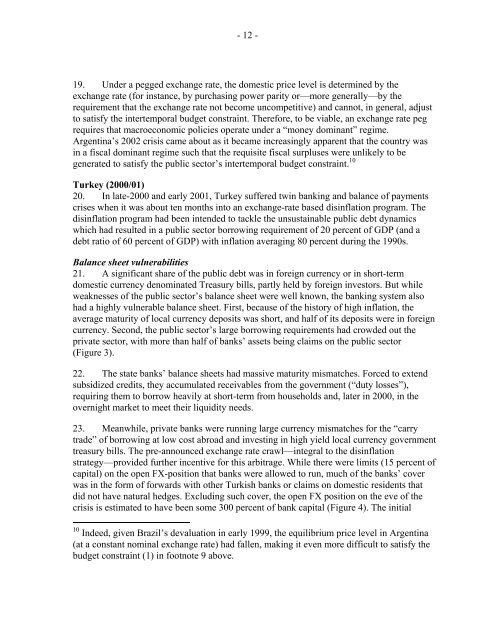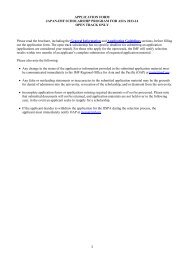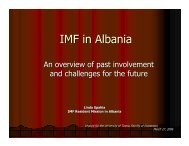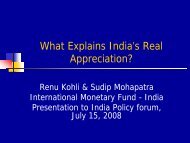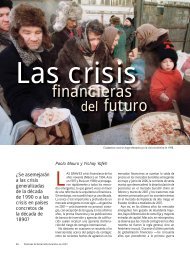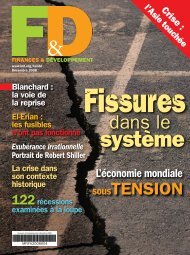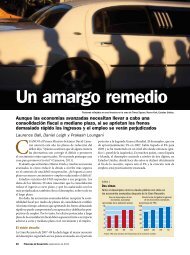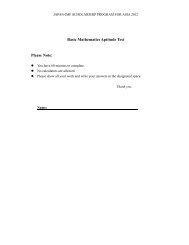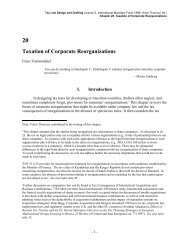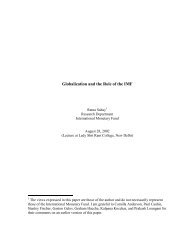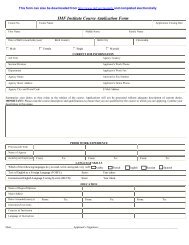Overview of Capital Account Crisis - IMF
Overview of Capital Account Crisis - IMF
Overview of Capital Account Crisis - IMF
You also want an ePaper? Increase the reach of your titles
YUMPU automatically turns print PDFs into web optimized ePapers that Google loves.
- 12 -<br />
19. Under a pegged exchange rate, the domestic price level is determined by the<br />
exchange rate (for instance, by purchasing power parity or—more generally—by the<br />
requirement that the exchange rate not become uncompetitive) and cannot, in general, adjust<br />
to satisfy the intertemporal budget constraint. Therefore, to be viable, an exchange rate peg<br />
requires that macroeconomic policies operate under a “money dominant” regime.<br />
Argentina’s 2002 crisis came about as it became increasingly apparent that the country was<br />
in a fiscal dominant regime such that the requisite fiscal surpluses were unlikely to be<br />
generated to satisfy the public sector’s intertemporal budget constraint. 10<br />
Turkey (2000/01)<br />
20. In late-2000 and early 2001, Turkey suffered twin banking and balance <strong>of</strong> payments<br />
crises when it was about ten months into an exchange-rate based disinflation program. The<br />
disinflation program had been intended to tackle the unsustainable public debt dynamics<br />
which had resulted in a public sector borrowing requirement <strong>of</strong> 20 percent <strong>of</strong> GDP (and a<br />
debt ratio <strong>of</strong> 60 percent <strong>of</strong> GDP) with inflation averaging 80 percent during the 1990s.<br />
Balance sheet vulnerabilities<br />
21. A significant share <strong>of</strong> the public debt was in foreign currency or in short-term<br />
domestic currency denominated Treasury bills, partly held by foreign investors. But while<br />
weaknesses <strong>of</strong> the public sector’s balance sheet were well known, the banking system also<br />
had a highly vulnerable balance sheet. First, because <strong>of</strong> the history <strong>of</strong> high inflation, the<br />
average maturity <strong>of</strong> local currency deposits was short, and half <strong>of</strong> its deposits were in foreign<br />
currency. Second, the public sector’s large borrowing requirements had crowded out the<br />
private sector, with more than half <strong>of</strong> banks’ assets being claims on the public sector<br />
(Figure 3).<br />
22. The state banks’ balance sheets had massive maturity mismatches. Forced to extend<br />
subsidized credits, they accumulated receivables from the government (“duty losses”),<br />
requiring them to borrow heavily at short-term from households and, later in 2000, in the<br />
overnight market to meet their liquidity needs.<br />
23. Meanwhile, private banks were running large currency mismatches for the “carry<br />
trade” <strong>of</strong> borrowing at low cost abroad and investing in high yield local currency government<br />
treasury bills. The pre-announced exchange rate crawl—integral to the disinflation<br />
strategy—provided further incentive for this arbitrage. While there were limits (15 percent <strong>of</strong><br />
capital) on the open FX-position that banks were allowed to run, much <strong>of</strong> the banks’ cover<br />
was in the form <strong>of</strong> forwards with other Turkish banks or claims on domestic residents that<br />
did not have natural hedges. Excluding such cover, the open FX position on the eve <strong>of</strong> the<br />
crisis is estimated to have been some 300 percent <strong>of</strong> bank capital (Figure 4). The initial<br />
10 Indeed, given Brazil’s devaluation in early 1999, the equilibrium price level in Argentina<br />
(at a constant nominal exchange rate) had fallen, making it even more difficult to satisfy the<br />
budget constraint (1) in footnote 9 above.


